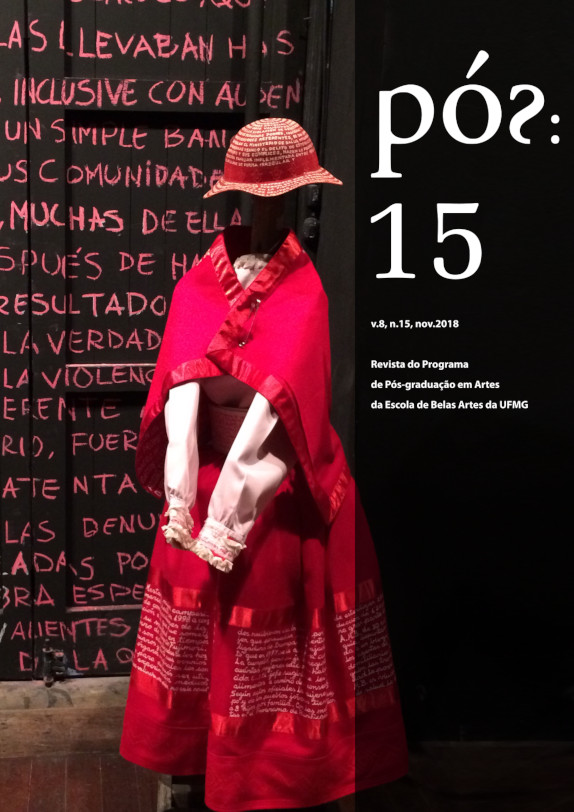Konstantin Stanislavski and the possibility of a holistic System for actors through I am
Keywords:
Konstantin Stanislavski, Yoha, HolismAbstract
This article presents, simultaneously, a systemic and holistic view of acting, exemplified by the concept I am, psychophysical state proposed by Konstantin Stanislavski. Inspired by Yoga, the Russian master combined scientific and spiritual ideals in his experiments; however, even today, we’re still trying to understand the concept of spirituality in his System. The article extends the discussion about the idea of Holism and what would imply a holistic understanding about the Stanislavski System for contemporary actors and researchers.
References
ABRISQUETA-GOMEZ, Jacqueline. Reabilitação neuropsicológica: abordagem interdisciplinar e modelos conceituais na prática clínica. Porto Alegre: Artmed, 2012.
PROCACCI, Silvana. “Holism: some historical aspects”. In: BENCI, Vieri [et al]. Determinism, Holism, and Complexity. New York: Kluwer Academic / Plenum Publishers, 2003.
CARNICKE, Sharon M. Stanislavsky in focus: an acting master for the twenty-first century. 2. ed. New York: Routledge, 2009.
CARNICKE, Sharon M. “Stanislavsky’s System – Pathways for the actor”. In: HODGE, Alison (ed.). Actor Training. 2. ed. New York: Routledge, 2010. 368 p. p. 1-25.
ESFELD, Michael. Holism in Philosophy of Mind and Philosophy of Physics. Dordrecht: Kluwer Academic Publishers, 2001.
FEUERSTEIN, Georg. Enciclopédia de Yoga da Pensamento. São Paulo: Pensamento, 2005b.
GORCHAKOV, Nikolai M. Stanislavsky directs. Translation: Miriam Goldina. New York: Funk & Wagnalls Company, 1954.
GORDON, Robert. The Purpose of Playing: Modern Acting Theories in Perspective. Ann Arbor: University of Michigan Press, 2006.
IYENGAR, B. K. S. Yoga: The Path to Holistic Health. New York: DK Publishing, 2001.
JONER, Vicente Mahfuz. O Yoga no Sistema de Konstantin Stanislávski: comunhão entre o espírito humano da personagem e o corpo humano do ator. 259 p. Dissertação (Mestrado em Teatro). Universidade do Estado de Santa Catarina, Centro de Artes, Programa de PósGraduação em Teatro, Florianópolis, 2014.
KEMP, Rick. Embodied Acting: what neuroscience tells us about performance. New York: Routledge, 2012.
KRASNER, David. “Stanislavsky’s System, Sense-Emotion Memory, and Physical Action/Active Analysis: American interpretations of the Systems’s legacy”. In: The Routledge Companion to Stanislavsky. New York: Routledge, 2013.
MERLIN, Bella. Konstantin Stanislavsky. New York: Routledge, 2003.
NUNES, Sandra Meyer. As metáforas do corpo em cena. São Paulo: Annablume/UDESC, 2009.
SCHECHNER, Richard. Public Domain: essays on the theater. [S. l.]: Bobbs-Merril, 1969.
SMUTS, Jan Christiaan. Holism and Evolution. 2. ed. London: Macmillan and Co.,1927.
STANISLAVSKI, Constantin. A criação de um papel. 12. ed. Rio de Janeiro: Civilização Brasileira, 2007.
STANISLAVSKI, Constantin. A preparação do ator. 24. ed. Rio de Janeiro: Civilização Brasileira, 2008a.
STANISLAVSKI, Konstantin. An Actor’s Work. New York: Routledge, 2008.
STANISLAVSKI, Konstantin. Minha vida na arte. Rio de Janeiro: Civilização Brasileira, 1989.
TCHERKASSKI, Sergei. “Stanislavsky and Yoga”. New York: Routledge, 2016.
VÁSSINA, Elena; LABAKI, Aimar. Stanislávski: vida, obra e Sistema. Rio de Janeiro: Funarte, 2015.
WHITE, R. Andrew. “Stanislavsky and Ramacharaka: The impact of yoga and the Occult Revival on the System”. In: The Routledge Companion to Stanislavsky. New York: Routledge, 2013.
WHITE, R. Andrew. “Stanislavsky and Ramacharaka: the influence of Yoga and turn-of-thecentury occultism on the system”. In: Theatre Survey, Vol. 47, n.1, may 2006, p. 73-92.
WHYMAN, Rose. The Stanislavsky System of acting: legacy and influence in modern performance. New York: Cambridge University Press, 2008.
ZARRILLI, Phillip B. Psychophysical acting: an intercultural approach after Stanislavski. New York: Routledge, 2009.
Downloads
Published
Issue
Section
License
Authors who publish in this journal agree to the following terms:
- Authors retain copyright and grant the journal the right of first publication, with the work simultaneously licensed under the a Creative Commons Attribution-NonCommercial 4.0 International License that permits sharing of the work with acknowledgement of authorship and initial publication in this journal;
- Authors are permitted to enter into additional contracts separately, for non-exclusive distribution of the version of the work published in this journal (e.g., the Creative Commons Attribution License).
- Authors are permitted and encouraged to publish and distribute their work online (e.g., in institutional repositories or on their home page) at any point before or during the editorial process, as this may generate productive changes as well as increase the impact and citation of the published work.
- It is the responsibility of the authors to obtain written permission to use in their articles materials protected by copyright law. Revista PÓS is not responsible for copyright breaches made by its contributors.












